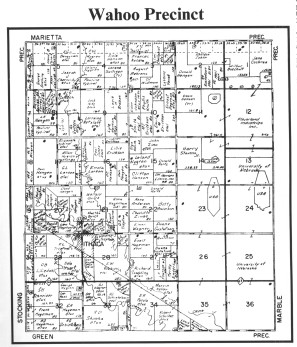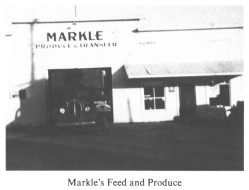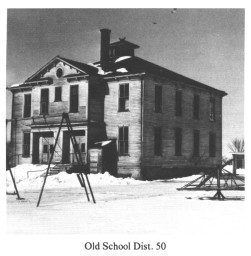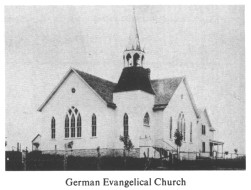 |
WAHOO PRECINCT |
 |
| (image links to larger map) |
|
population again became stable. Many farmers moved to Ithaca in their retirement years.
A community hall was built in the 1930's. This served as a place of entertainment for social gatherings and school activities. Roller skating was a big source of enjoyment during these years in the hall. Free silent movies had been a source of pleasure to the community. These were sponsored by the merchants of the town and were held out under the stars in the summer. A new school replaced the old ten grade school in 1948. Many of the community had received their education here. It is now a K-6 school. As the century moved on some businesses closed; others took their place. Buck and Edna Wolfe's cafe and garage, Basil's grocery store, which later became Ralph Treptow's store, prospered. Ithaca had a bicentennial celebration on June 27, 1976. The community spirit lingers on. Today the town has a Farmers Coop Grain Elevator, Hanson's Well Company, Tomsicek Manufacturing Company, Hass Trucking, a Post Office and Elsie's Cafe. Changes have taken place over the years. There are fewer businesses in 1982. The United Methodist Church now serves as the only church in the community. Memorial Day is observed not only to honor the men who served in the armed forces but to remember the pioneers who came and are now buried in the Ithaca Mound Cemetery. There are many fourth and fifth generations descendants and a few sixth generation ones living in this area; many will have their histories in this book. Ithaca in 1982 is alive and thriving and looking forward to a prosperous future. Written by Faith Dech Smith
SCHOOL DISTRICT 50, ITHACAThe first school in District 50 was built by Elijah Dech in Section 20 of Wahoo Township. He built it on his own farm and his daughter, Martha, was the first teacher. When the new school was built, the old schoolhouse was moved into Ithaca and remodeled for use as a home. The new school consisted of two rooms, one upstairs, and one downstairs. The first school records remaining in the district date back to 1892. The teachers were Gilbert Hoppel and Blanche Roberts and there were 39 students on the roll. As the school grew and the students progressed, grades were added until they included one through nine. In 1908, four students graduated from the ninth grade. In about 1908, the schoolhouse was enlarged. Two rooms were added to the west side of the building. In about 1916, a basement was put under the building and a furnace was installed. A well was dug so the school would have its own water supply. Prior to that, students had to carry water by buckets every day from the home of Mr. Knapp, one block south of the school. In 1922, the school added the tenth grade. It continued with ten grades until May, 1947. The present school was built in 1948 and located north of the old building. The cost was approximately $30,000.
In 1970, District 50 consolidated with District 102, thereby enlarging the district and the number of students. The patrons voted to contract the seventh and eighth grades to Wahoo or Mead so they could participate in Junior High programs. Since that time the school has included kindergarten through grade 6. When the Methodist and United Brethren Churches united, the school purchased the Methodist Church building and had it moved in 1969 to the east side of the school building. It was remodeled into a gym for the use of the students and for other community functions. In 1981, a new roof was put on the present school building. In September of 1982, 29 students were enrolled in grades K-6. The teachers were Mrs. Dorothy Klink and Mrs. Pam Trutna. Mrs. Leon Teetor served as aide. School board members included: Bruce Shepherd -- President; Linda Kapple -- Treasurer; Debbie Bahm -- Secretary; Brad Shawhan and Jan Givens. NOTE: This history was compiled from records of the district and from information received from former students. Some of the dates may not be exact and some of the facts are different in different reports. ITHACA WOMEN'S CLUBA group of women from the Ithaca Community organized as an Extension Club in the year of 1923. This club was called the Ithaca Homemakers. On a hot afternoon of May 27, 1927, the Ithaca Homemakers met at the Ithaca School building to organize as a Federated Women's Club. The name selected was Ithaca Women's Club. The Club became active in the Saunders County Federation of Women's Club. Two of its members served as County President, three as Vice-President and one as Secretary. It was decided that all members signing the Constitution by September 1, 1927, would be charter members, of which there were 48. The Ithaca Club was both an extension club and a Federated club until the year of 1956 when we dropped from the federation and became an extension club only. The early meetings of the club were held in a clubroom, which was located in an old store building that had been a hardware and drug store owned by Mr. J.M. Hall. The club members cleaned the building and brought their own fuel, such as wood, to heat the building. In 1924, a member, Alberta O'Kane entered a contest sponsored by a Women's Magazine on "Why We Need a Community House". For this article she won $100 which she put out on interest. Each year the Club added to this fund until there was $500. Crops and prices were poor in 1933 but the Women's Club with the other organizations of the Community banded together to get the Community Hall Building started and built. All through the years the Ithaca Women's club has been very active in the community. Some of the other projects have been Drama Club, Flower Show, Quilt Shows and Bridal Parties. We received a citation when we banded with another club and got flashing lights at the railroad crossing by the Mead Alfalfa Mill. Those serving as Presidents over the years were Miss Alberta O'Kane, Mmes. Ben Noerenberg, Russell Roberts, Roy Hageman, Ernest Hageman, LeRoy Frahm, Harold Robbins, Rodger McKlem, Duane Gustafson, Gerald Treptow, George Hageman, Robert Hageman, Milton Eichmeier, Wallace Quick, Dale Noerenberg, Edwin Hass, Ralph Hageman, Blaine Rish, Casey Jones, and Julius Izso. On May 27, 1977, old friends and former members joined in celebrating with the members for its Golden Anniversary at the Community Building. Seven of the original 48 charter members were able to be present. They were Alma Hageman, Mmes Edward Hageman, Ernest Hageman, Ewalt Hageman, Sr., Edward Scheuneman, all of Ithaca, Mrs. Lester Sherfey of Ogalla, La., and Mrs. Ben Noerenberg of Lincoln.
THE EBENEZER EVANGELICAL |
| Back | Contents | Next |
The Saunders County NEGenWeb Project



